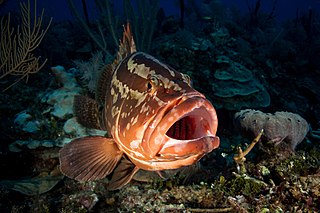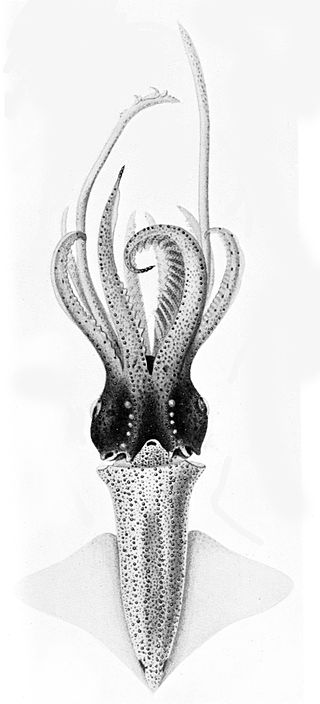
Herring are forage fish, mostly belonging to the family of Clupeidae.

Inia is a genus of river dolphins from South America, containing one to four species.

The Nassau grouper is one of the large number of perciform fishes in the family Serranidae commonly referred to as groupers. It is the most important of the groupers for commercial fishery in the West Indies, but has been endangered by overfishing.

The western rock nuthatch is a small passerine bird which breeds from Croatia east through Greece and Turkey to Iran. This nuthatch is largely resident apart from some post-breeding dispersal. The eastern rock nuthatch Sitta tephronota is a separate species, which occurs further east in south-central Asia.

The tūī is a medium-sized bird native to New Zealand. It is blue, green, and bronze coloured with a distinctive white throat tuft (poi). It is an endemic passerine bird of New Zealand, and the only species in the genus Prosthemadera. It is one of the largest species in the diverse Australasian honeyeater family Meliphagidae, and one of two living species of that family found in New Zealand, the other being the New Zealand bellbird. The tūī has a wide distribution in the archipelago, ranging from the subtropical Kermadec Islands to the sub-Antarctic Auckland Islands, as well as the main islands.
The conservation status of a group of organisms indicates whether the group still exists and how likely the group is to become extinct in the near future. Many factors are taken into account when assessing conservation status: not simply the number of individuals remaining, but the overall increase or decrease in the population over time, breeding success rates, and known threats. Various systems of conservation status are in use at international, multi-country, national and local levels, as well as for consumer use such as sustainable seafood advisory lists and certification. The two international systems are by the International Union for Conservation of Nature (IUCN) and The Convention on International Trade in Endangered Species of Wild Fauna and Flora (CITES).

The Réunion cuckooshrike is a passerine bird in the cuckooshrike family. It is endemic to the island of Réunion, where it is restricted to two areas of mountain forest in the north of the island. Males are dark grey above and pale grey beneath, while females have dark brown upper parts and a streaked breast. The population has been declining and the range contracting, being currently about 16 square kilometres (6.2 sq mi), and the International Union for Conservation of Nature has rated the species as "critically endangered", with the possibility that the bird could be wiped out by a tropical storm. Conservation efforts are being made by attempting to control the cats and rats which prey on the chicks, and this seems to have resulted in the population stabilising.

The tui parakeet is a species of bird in subfamily Arinae of the family Psittacidae, the African and New World parrots. It is found in Bolivia, Brazil, Colombia, Peru, and possibly Ecuador.

Abraliopsis morisii is a species of bioluminescent squid in the family Enoploteuthidae. The species occurs in tropical to warm temperate waters in the Atlantic Ocean, including the Gulf of Mexico and the Mediterranean Sea. It can be found in the epipelagic and mesopelagic zones. Jean Baptiste Vérany described the species in 1839 and it reaches lengths of 25 to 33 millimetres. It is rated as least concern by the International Union for Conservation of Nature (IUCN).
Abraliopsis affinis is a species of enoploteuthid cephalopod in the tropical waters of the eastern Pacific Ocean, and is known from Chile, Colombia, Costa Rica, Ecuador, El Salvador, Guatemala, Honduras, Mexico, Nicaragua, Panama and Peru. It was described by Pfeffer in 1912 and is rated as a least-concern species by the IUCN.
Abraliopsis atlantica is a species of enoploteuthid cephalopod found in the tropical and subtropical Atlantic Ocean, including the Caribbean Sea, the Gulf of Mexico and the Benguela Current. Female oocytes are around 1 mm in length and number between 4,000 and 29,000 in mature females. There is a lack of information about the species and it is rated as data deficient by the International Union for Conservation of Nature (IUCN) due to this. It was described by Kir Nesis in 1982.
Abraliopsis chuni is a species of enoploteuthid cephalopod known from Indo-Pacific waters. Very little is known of this species.
Abraliopsis falco is a species of enoploteuthid cephalopod found in the tropical waters of the East Pacific Ocean, and is known from Chile, Colombia, Costa Rica, Ecuador, El Salvador, Guatemala, México, Nicaragua, Panamá, Perú and the United States. Females are larger than males, reaching sizes of 41–46 mm mantle length, with males reaching 35–37 mm mantle length.

Abraliopsis felis is a species of enoploteuthid cephalopod found in cool temperate water of the north Pacific Ocean. Female oocytes measure 1.5 mm in length.
Abraliopsis gilchristi is a species of enoploteuthid cephalopods found in southern temperate waters of the south Pacific Ocean, from New Zealand to South Africa, where it is abundant. It undergoes a vertical daily migration, spending the day at depth and moving closer to the surface at night to feed on copepods, euphausiids and hyperiids. Spawning appears to occur between September and December. The specific name honours the Scottish zoologist John Gilchrist (1866-1926) who was the first director of the Marine Biological Survey in Cape Town. The type specimen was taken off Cape Town and is held in the Natural History Museum, London.

Abraliopsis hoylei is a species of enoploteuthid cephalopod whose type locality is the Mascarene Islands, but this is uncertain, and the type specimen has been damaged, making taxonomic determination difficult.
Abraliopsis lineata is a species of enoploteuthid cephalopod native to Indo-Pacific waters, from the Arabian Sea and the Mascarene Islands in the west to Japan, Indonesia and French Polynesia in the east. It occurs in relatively shallow water at depths of ~100 m during the day.
Abraliopsis pacificus is a species of enoploteuthid cephalopod from the northwestern Pacific Ocean, from Japan to Hawaii. This species undergoes vertical migration from 900–500 m depth during the day, rising to 263–102 m depth at night. Male spermatophores are 6.5–7 mm in length.

Abraliopsis pfefferi, also known as Pfeffer's enope squid, is a species of squid from the genus Abraliopsis. The species has been observed in the North Atlantic Ocean.










